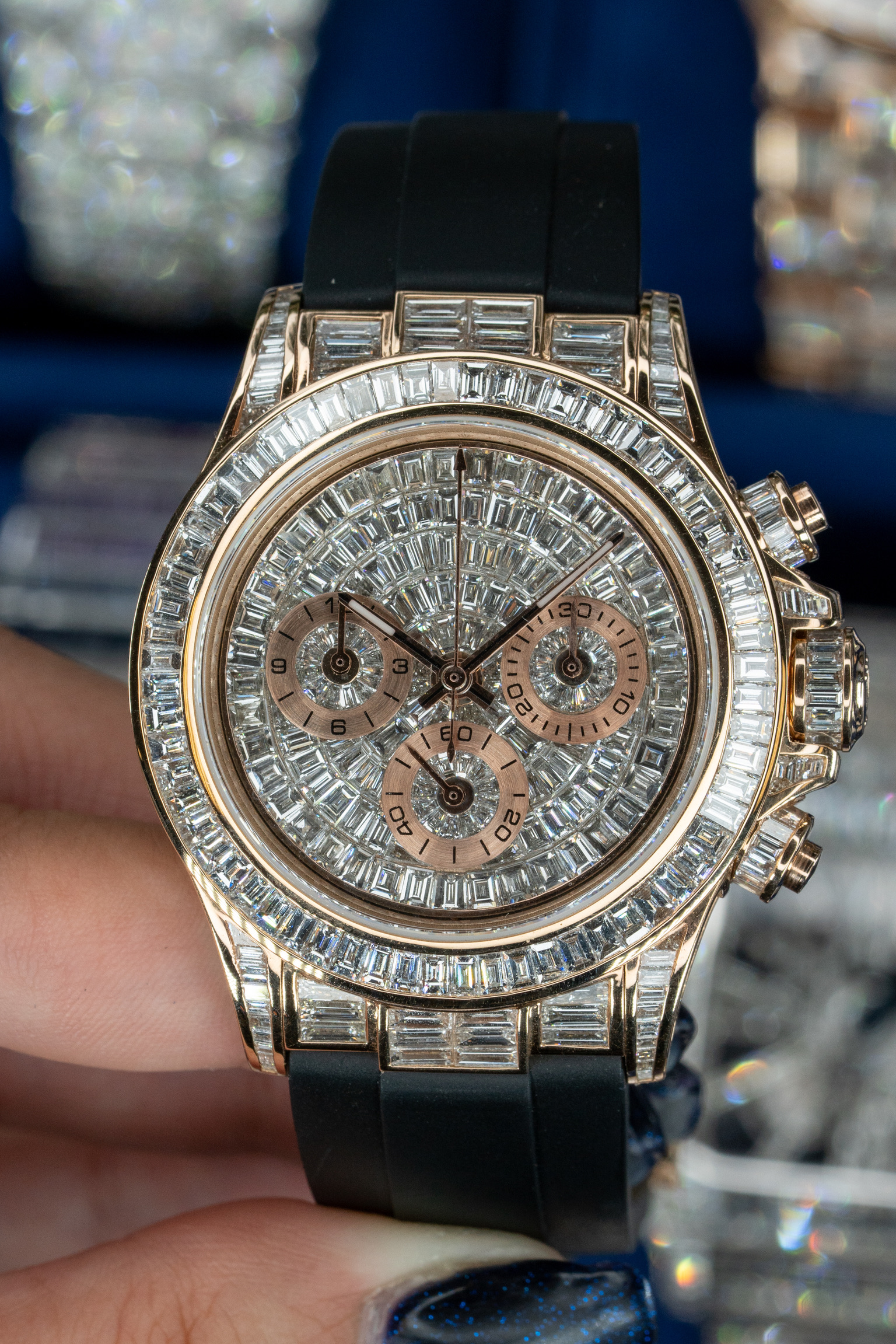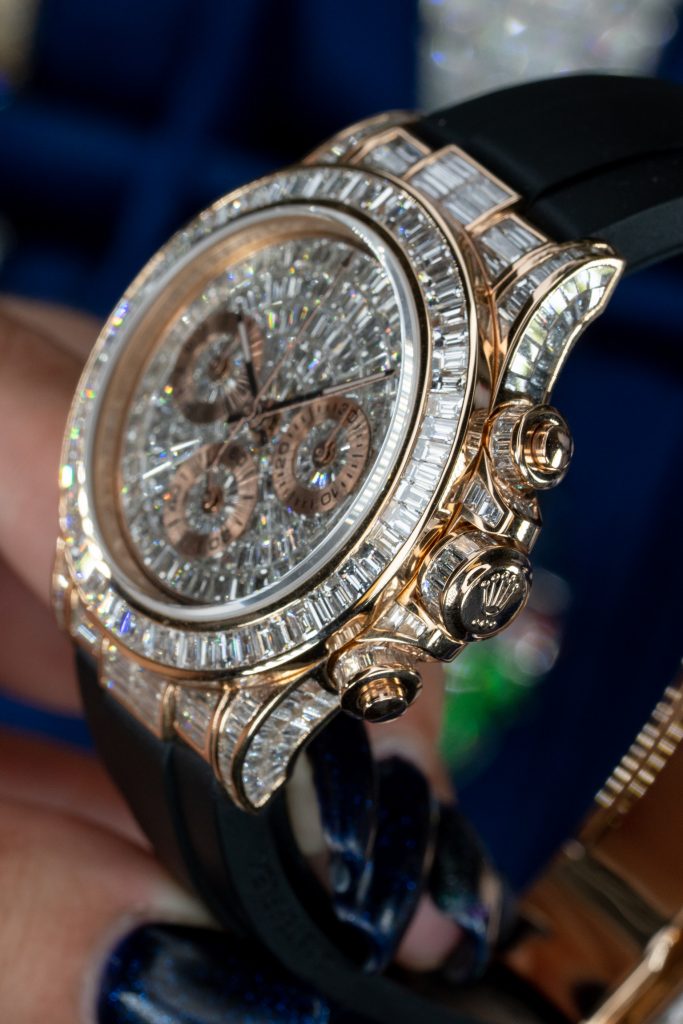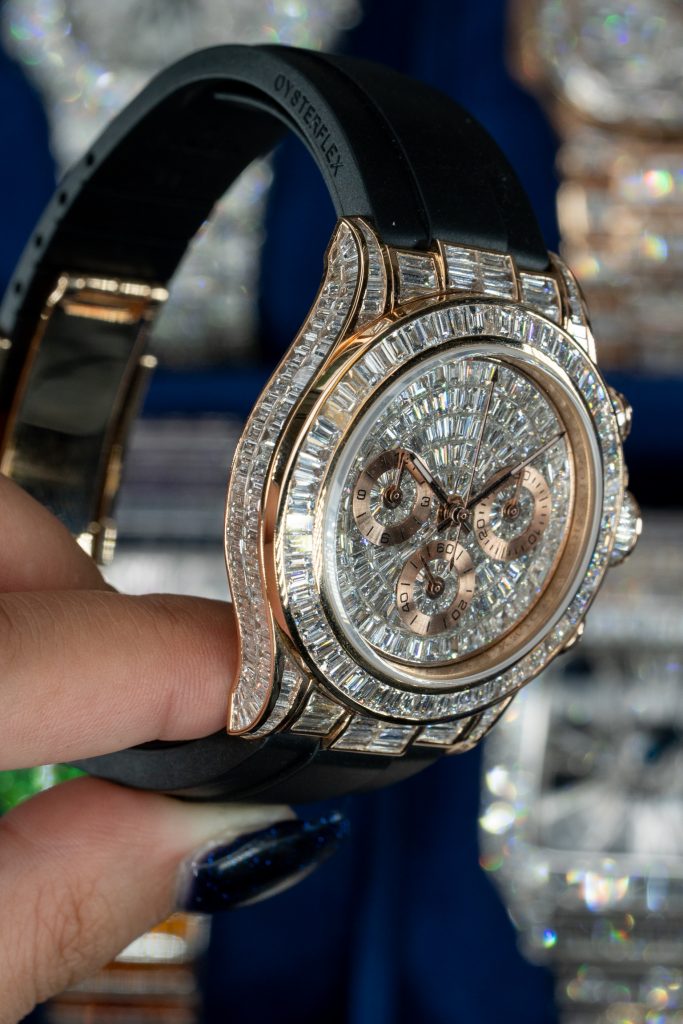Rose Gold Baguette Rolex Daytona on Rubber

The Rose Gold Baguette Rolex Daytona on Rubber was one of Rolex’s automatic chronograph watches. Introduced in the late eighties; It was among the last Rolex models to use a third-party movement. At the same time, the Luxury Rolex Daytona on Rubber also marks the point in the model’s history. It came into limelight when Rolex started to build the collection and expand the number of available options. This makes the Baguette Rolex Daytona incredibly interesting to study and collect. It can also make it slightly more difficult to figure out which variation of the watch belongs on your wrist. So, where do you start?
What Is the Baguette Rolex Daytona?
A Rose Gold Baguette Rolex Daytona looks similar to a later-era Rolex Daytona with an in-house movement. It is powered by a different caliber. The Luxury Rolex Daytona on Rubber is also the first model to introduce the core features which defines the collection. The first generation of manually-wound Daytona watches often receives the lion’s share of the attention from the vintage collecting community. Baguette Rolex Daytona represents the point in the model’s history where Rolex’s legendary racing chronograph took a nice turn on its contemporary form.
The Baguette Rolex Daytona came into existence in a wide variety of configurations during its relatively short production run. There are many common features and design elements present on every single watch from this generation of Rolex chronographs. Regardless of the specific reference, materials, dial style, or bezel type, all Rolex Daytona watches
- feature 5-digit reference numbers,
- 40mm cases with crown-guards,
- screw-down chronograph pushers,
- sapphire crystals,
- and El Primero-based Caliber 4030 movements.

What Makes the Luxury Rolex Daytona on Rubber So Special?
A major factor in the Luxury Rolex Daytona on Rubber’s appeal is that it represents a lot of firsts. Both for the Daytona collection and the Rolex brand as a whole. It holds the distinction of being Rolex’s original automatic chronograph watch. And it will always occupy an incredibly special place in the brand’s history simply due to that fact alone. However, it was also the first Daytona model to feature a sapphire crystal. The first with a 40mm case diameter, the first to feature crown-guards. And the first to introduce a two-tone steel and gold configuration to the collection.
Do you know that the production of the Baguette Rolex Daytona lasted until 200? It is also the last Rolex watch to use an outsourced movement before the brand switched entirely to in-house calibers. In fact, the “Baguette Rolex Daytona” moniker is actually just a nickname that comes from its automatic chronograph movement. The Caliber 4030 fitted to this particular Rolex Daytona is almost similar to El Primero movement. You will find it inside one of the Baguette rubber watches.
A major factor in the Baguette Daytona’s appeal is that it represents a lot of firsts. Both for the Daytona collection and the Rolex brand as a whole.
Rose Gold Baguette Rolex Daytona Materials

From the beginning, the Rolex Daytona came in either stainless steel or rose gold. The brand’s signature Rolesor configuration became an option at two occasions:
- Introduction of the Luxury Rolex Daytona on Rubber.
- and the arrival of the second generation of Rolex’s chronograph.
The two-tone Daytona is a watch that almost seems like it has existed for long. The collection has been a part of Rolex’s catalog for some time. But it is actually this Zenith-powered generation that first introduced the steel and gold option.
Production of the Rose Gold Baguette Rolex Daytona pre-dates the revival of rose gold in Rolex’s catalog. It occurred in 2005 when the brand introduced its proprietary 18k pink gold alloy known as Everose gold. This means that there are no rose gold models from the Rose Gold Baguette Rolex Daytona generation. Alongside the traditional rose gold watches, Rolex did produce a handful of luxury-oriented references crafted from solid 18k white gold.
Technically speaking, this Luxury Rolex Daytona on Rubber is not the first time crafted from this material. There is a reference 6265 from 1970 produced in white gold. This one example is truly an anomaly.
Additional Information on Rose Gold Baguette Rolex Daytona Materials
Additionally there are also five known examples of the Luxury Rolex Daytona on Rubber crafted from solid platinum. They produced the five-piece run of reference 16516 watches in 1999. At the request of former Rolex CEO Patrick Heiniger came this beautiful piece. He kept one for himself and gave the other four away as gifts to key business partners.
Each of these watches came with a dial that featured a different exotic material or semi-precious stone. While these platinum Rose Gold Baguette Rolex Daytona watches certainly do exist, you aren’t likely to encounter one for sale. Expect to pay at least a few million dollars if you want to add it to your collection. That’s if you do find it.
Technically speaking, the Luxury Rolex Daytona on Rubber represents the first time that Rolex produced platinum Daytona. The Baguette Rolex Daytona marks the formal introduction of both two-tone and white gold models to Rolex’s chronograph collection. The addition of these two metal options brings the total to four within the Baguette Rolex Daytona collection.
- stainless steel,
- two-tone,
- rose gold,
- and white gold.

Baguette Rolex Daytona Dial Options
When it comes to dials, the available options are typically determined by the metal type of a specific reference. For example, the Rolex Daytona on Rubber (stainless steel version) only fitted with either a white or black dial. And regardless of the color that you choose, both comes with classic luminous-filled stick markers.
You may come across the term, “Patrizzi dial” in reference to certain examples of the stainless steel baguette Daytona. This simply refers to those that display a darkening of the originally silver-colored rings on their sub-dials. The darkening is due to oxidation that results from an imperfection in the varnish used during the mid-90s. The darkening of the sub-dials is an entirely natural process. Color can vary between watches and no two examples will be entirely identical.
Furthermore, on the dials of both the two-tone and solid Baguette Rolex Daytona references, you also have three choices. You can choose between traditional luminous-filled stick indexes, Arabic numerals, or diamond-set hour markers. Not all dial colors are available with all styles of indexes. But, you can find the gem-set markers and Arabic numerals on the dials of either two-tone or solid gold Luxury Rolex Daytona on Rubber.
Lastly, it’s also worth noting that due to the timing of the baguette Daytona’s production run, the luminescent material featured on its dial and hands can either be tritium or Luminova. The switch took place during the late 1990s, and the Luxury Rolex Daytona on Rubber dials with tritium are marked with “T Swiss Made T” at the 6 o’clock location and will no longer glow anymore, while those furnished with Luminova simply just say “Swiss Made” and will glow in response to light.
Additional Gem-Set Models
Beyond the standard-production models, Rolex also created a number of ultra-luxurious variations of the Luxury Rolex Daytona on Rubber that were lavishly set with diamonds and other precious gemstones. These models were exclusively crafted from solid 18k gold, produced in extremely small numbers, and many of them were never officially part of Rolex’s standard catalog.
In fact, Rolex still produces a handful of gem-encrusted watches each year, and you will not find them listed anywhere on the brand’s official website. Rolex may have built much of its legendary reputation by manufacturing practical and reliable tool watches, but the company’s luxurious gem-set models are so lavish, in-your-face, and truly unlike anything else that it produces that you can hardly believe they are actually something that Rolex created.
Additional Information
For example, the Luxury Rolex Daytona on Rubber is a solid rose gold Daytona on a Daytona on Rubber that is fitted with a bezel set with baguette-cut emeralds and a diamond-paved dial with emerald hour markers. Similarly, the Luxury Rolex Daytona on Rubber is a rose gold Daytona on a leather strap that features a bezel set with cognac-colored sapphires, a mother-of-pearl dial with diamond hour markers, and lug hoods further adorned by both diamonds and cognac-colored sapphires. To this day, Rolex still produces ultra-luxurious editions of its famous chronograph, and while these watches may look like custom works, they are actually created entirely by Rolex and represent some of the most luxurious watches in the brand’s entire portfolio.
You aren’t likely to find all that many of these gem-set Daytona watches available for sale, but it is still important to be aware of the fact that they are out there and do occasionally surface at auction. These ultra-luxurious models definitely don’t offer the same look and feel of the classic Rolex Daytona, but they are the perfect watches for those that want the hands-down most lavish versions of the Luxury Rolex Daytona on Rubber that money can buy.
Choosing a Rolex Daytona on Rubber

When choosing which Luxury Rolex Daytona on Rubber, probably the easiest starting point will be to first select the metal type, as this will determine the rest of the options that will be available. For example, if you want a stainless steel model, then the only two decisions you need to make are whether you want a black or white dial and whether you want your watch to have vintage tritium lume or photo-reactive Luminova.
With that in mind, it is also worth considering the different prices of the Luxury Rolex Daytona on Rubber because there exists a huge range in values. Naturally, the incredibly exclusive gem-set references are by-far the most expensive, and many of them trade hands for values in excess of six-figures whenever they surface at auction. As we would suggest, the next most expensive models are those crafted from solid gold, but when it comes to the stainless steel and two-tone examples, the most humble metal option is not at all the least expensive.
It’s hardly a secret that stainless steel Rolex sports watches are incredibly popular and the Rose Gold Baguette Rolex Daytona is no different. At retail, two-tone Rolex watches always cost more than their stainless steel counterparts but on the open market, things are quite a bit different. Generally speaking, you should expect to pay a minimum of several thousand dollars more for a Luxury Rolex Daytona on Rubber than its two-tone equivalent.
A Modern Classic
When it first appeared in the eighties, the Luxury Rolex Daytona on Rubber represented a major step forward for the collection but its core design now serves as the basis for one of the world’s most desirable timepieces. What you get with the Baguette Rolex Daytona is a watch that looks and feels rather similar to the modern Daytona models that Rolex produces today, but with a ton of additional historical significance.
The Rose Gold Baguette Rolex Daytona was one of Rolex’s first self-winding chronographs, the first 40mm Daytona, the first to introduce two-tone and white gold models to the collection, and the first to feature both crown guards and a sapphire crystal. At the same time, it was also the last Rolex watch to feature an outsourced movement and the last Daytona model to use radioactive tritium for its luminescence. And yet, despite being representative of all these firsts and lasts, the Luxury Rolex Daytona on Rubber feels instantly familiar.
In recent years, the Luxury Rolex Daytona on Rubber has become the Rolex watch to own.
The reason why the Rose Gold Daytona shares so much of its core design DNA with modern Daytona watches is because it was the model to first introduce these key features that would later become defining elements of the collection. At the same time, the Rose Gold Daytona is not a modern Rolex watch. It is powered by a third-party movement, the majority of examples feature tritium dials, and even the most recently-produced ones originally left the Rolex factory several years ago.

